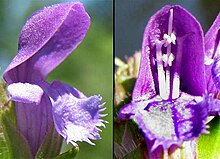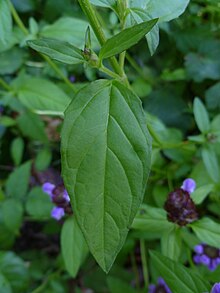| Prunella vulgaris | |
|---|---|

| |
| Conservation status | |
 Least Concern (IUCN 3.1) | |
 Secure (NatureServe) | |
| Scientific classification | |
| Kingdom: | Plantae |
| Clade: | Tracheophytes |
| Clade: | Angiosperms |
| Clade: | Eudicots |
| Clade: | Asterids |
| Order: | Lamiales |
| Family: | Lamiaceae |
| Genus: | Prunella |
| Species: | P. vulgaris |
| Binomial name | |
| Prunella vulgaris L. | |
| Subspecies | |
| |
Prunella vulgaris, the common self-heal, heal-all, woundwort, heart-of-the-earth, carpenter's herb, brownwort or blue curls, is a herbaceous plant in the mint family Lamiaceae.
Description

Prunella vulgaris grows 5–30 cm (2.0–11.8 in) high, with creeping, self-rooting, tough, square, reddish stems branching at the leaf axes.
The leaves are lance-shaped, serrated and reddish at the tip, about 2.5 cm (0.98 in) long and 1.5 cm (0.59 in) broad, and growing in opposite pairs down the square stem. Each leaf has 3-7 veins that shoot off the middle vein to the margin. The stalks of the leaves are generally short, but can be up to 5 cm (2.0 in) long.

The flowers grow from a clublike, somewhat square, whirled cluster; immediately below this club is a pair of stalkless leaves standing out on either side like a collar. The flowers are two-lipped and tubular. The top lip is a purple hood, and the bottom lip is often white; it has three lobes, with the middle lobe being larger and fringed upwardly. Flowers bloom at different times depending on climate and other conditions, but mostly in summer (from June to August in the USA).
Self-heal propagates both by seed and vegetatively by creeping stems that root at the nodes.
Two subspecies of Prunella vulgaris have been identified: var. vulgaris and var. lanceolata.
Habitat
Prunella vulgaris is a perennial herb native in Europe, Asia, Africa, and North America, and is common in most temperate climates. It was introduced to many countries in the 1800s and has become invasive in the Pacific Islands, including Australia, New Zealand, and Hawaii. In Ireland, it is generally abundant. This herb also grows in Kashmir where it is known as kalyuth. It is boiled in water, which is used to wash and bathe in order to relieve muscle pain.
It grows on roadsides, gardens, waste-places, and woodland edges, and usually in basic and neutral soils.
Uses

Prunella vulgaris is edible. The young leaves and stems can be eaten raw in salads; the plant as a whole can be boiled and eaten as a leaf vegetable; and the aerial parts of the plant can be powdered and brewed in a cold infusion to make a beverage.
The herb, which is called xia ku cao (夏枯草) in Chinese, is used in traditional Chinese medicine to treat dizziness, red eyes, dry cough, and dermatitis and boils. It is also a main ingredient in several herbal teas in southern China, including commercial beverages such as Wong Lo Kat.
The Nlaka'pamux drink a cold infusion of the whole plant as a common beverage. The plant is traditionally used by some Indigenous cultures to treat various physical ailments.
Phytochemicals
Phytochemicals include betulinic acid, D-camphor, D-fenchone, cyanidin, delphinidin, hyperoside, manganese (not a phytochemical), lauric acid, oleanolic acid, rosmarinic acid, myristic acid, rutin, linoleic acid, ursolic acid, beta-sitosterol, lupeol, and tannins.
Etymology
Prunella is derived from 'Brunella', a word which is itself a derivative, taken from "die Bräune", the German name for diphtheria, which Prunella was historically used to cure. Vulgaris means 'usual', 'common', or 'vulgar'.
Self-heal and heal-all refer to its uses in traditional medicine.
References
- Maiz-Tome, L. (2016). "Self-heal Prunella vulgaris". IUCN Red List of Threatened Species. 2016: e.T203256A78457152. doi:10.2305/IUCN.UK.2016-1.RLTS.T203256A78457152.en. Retrieved 31 July 2022.
- NatureServe (6 December 2024). "Prunella vulgaris". NatureServe Explorer. Arlington, Virginia. Retrieved 21 December 2024.
- "Prunella vulgaris L." Plants of the World Online. Royal Botanic Gardens, Kew. Retrieved 21 December 2024.
- ^ "Prunella vulgaris (self-heal)". CABI. 2019-11-19. Retrieved 2020-07-21.
- Gray, Samuel F. (1821). Natural Arrangement of British Plants: According to Their Relations to Each Other, as Pointed Out by Jussieu, De Candolle, Brown &c... vol 2. Baldwin, Cradock and Joy. p. 389.
- Lust, John (2014). The Herb Book: The Most Complete Catalog of Herbs Ever Published (Dover republication ed.). USA: Courier Corporation. p. 399. ISBN 9780486794785.
- Fisher, Robert (1932). The English Names of Our Commonest Wild Flowers ... T. Buncle & Company. p. 195.
- Clapham, A.R., Tutin, T.G. and Warburg, E.F. 1968. p. 347. Excursion Flora of the British Isles. Cambridge University Press. ISBN 0-521-04656-4
- ^ "Conservation Plant Characteristics for Prunella vulgaris L. (common selfheal)". Plants Database. United States Department of Agriculture.
- Duke, James (2001). "Prunella vulgaris". Handbook of Edible Weeds. CRC. p. 158. ISBN 978-0-8493-2946-3.
- DiTomaso, Joseph M.; Healy, Evelyn A. (2007). Weeds of California and Other Western States, Volume 1. ANR. p. 884. ISBN 978-1-879906-69-3.
- "Calflora: Plant Search". www.calflora.org. Retrieved 2020-07-22.
- "Prunella vulgaris key to species, Jepson eFlora". ucjeps.berkeley.edu. Retrieved 2020-07-22.
- PIER, 2016. Honolulu, USA: HEAR, University of Hawaii. Pacific Island Ecosystems at Risk
- ^ Parnell, J. and Curtis, T. 2012. Webb's An Irish Flora. Cork University Press. ISBN 978-185918-4783
- Scannell, M.P. and Synnott, D.M. 1972 Census Catalogue of the Flora of Ireland. Dublin Stationery Office
- Fayaz, Mufida; Jain, Ashok K.; Bhat, Musadiq Hussain; Kumar, Amit (2019). "Ethnobotanical Survey of Daksum Forest Range of Anantnag District, Jammu and Kashmir, India". Journal of Herbs, Spices & Medicinal Plants. 25: 55–67. doi:10.1080/10496475.2018.1564950. S2CID 92152206.
- Foster, Steven; Hobbs, Christopher (2002). "Self-heal, Heal-All". A Field Guide to Western Medicinal Plants and Herbs. Houghton Mifflin Harcourt. p. 231. ISBN 978-0-395-83806-8.
- "Selfheal - Prunella vulgaris". www.washcoll.edu. Retrieved 2023-04-12.
- Harford, Robin (2019-08-23). "Selfheal". EATWEEDS. Retrieved 2023-04-12.
- "Chinese Medicine Specimen Database". 2016-03-04. Archived from the original on 4 March 2016. Retrieved 2022-05-29.
- "Wong Lo Kat Chinese Herbal Tea (Ingredients List)". Wai Yee Hong. Retrieved 25 July 2020.
- Meuninck, Jim (2008). Medicinal Plants of North America: A Field Guide. Globe Pequot Press. p. 41. ISBN 978-0-7627-4298-1.
- Fagan, Damian (2019). Wildflowers of Oregon: A Field Guide to Over 400 Wildflowers, Trees, and Shrubs of the Coast, Cascades, and High Desert. Guilford, CT: FalconGuides. p. 172. ISBN 978-1-4930-3633-2. OCLC 1073035766.
- Khare, C.P. (2007). Indian Medicinal Plants: An Illustrated Dictionary. Springer. p. 103. ISBN 978-0-387-70637-5.
- Duke, James A.; Beckstrom-Sternberg, Stephen M. (2001). Handbook of Medicinal Mints (Aromathematics): Phytochemicals and Biological Activities. CRC. p. 222. ISBN 978-0-8493-2724-7.
- ^ Gledhill, David (2008). "The Names of Plants". Cambridge University Press. ISBN 9780521866453 (hardback), ISBN 9780521685535 (paperback). pp 316, 404
| Taxon identifiers | |
|---|---|
| Prunella vulgaris |
|